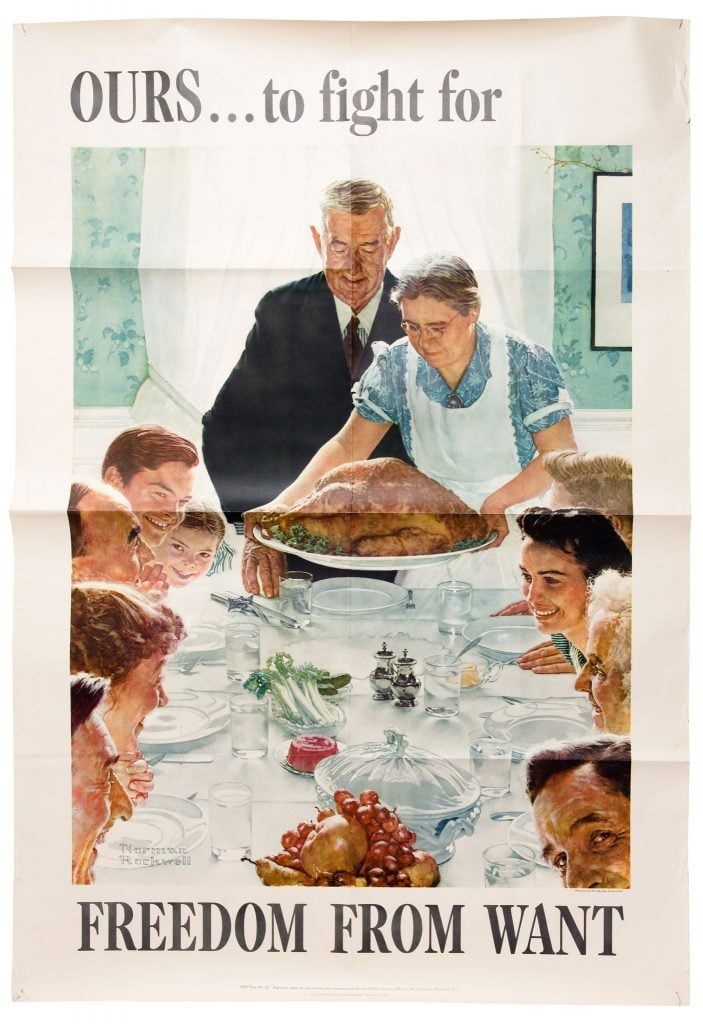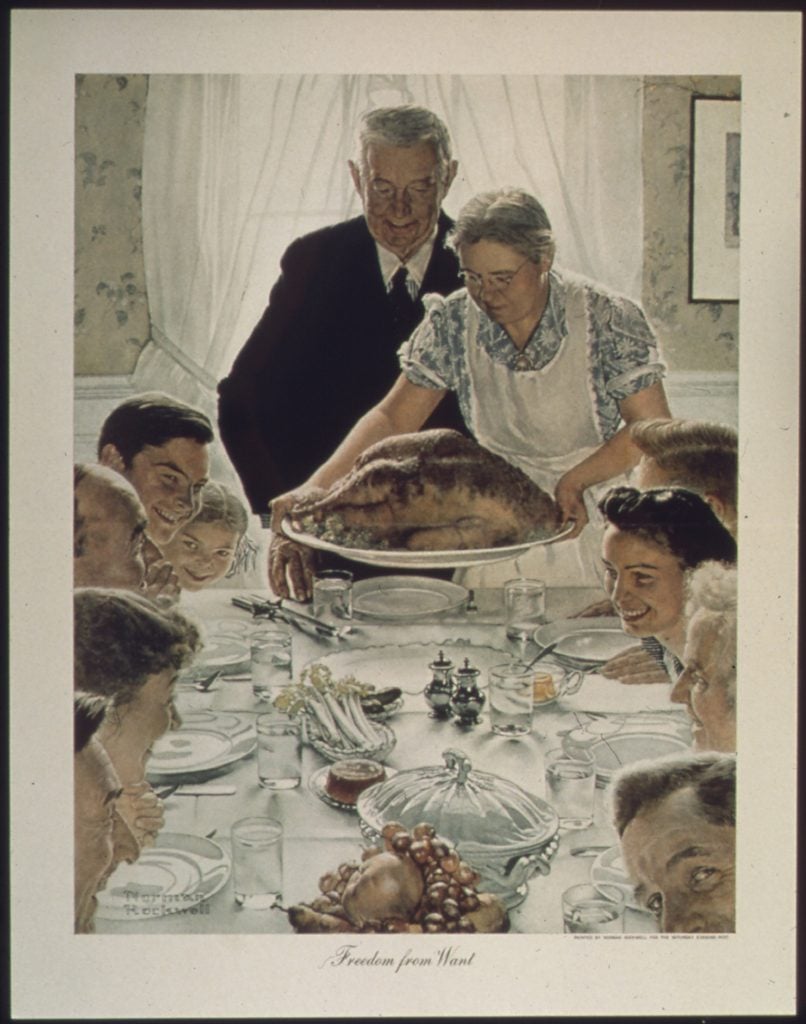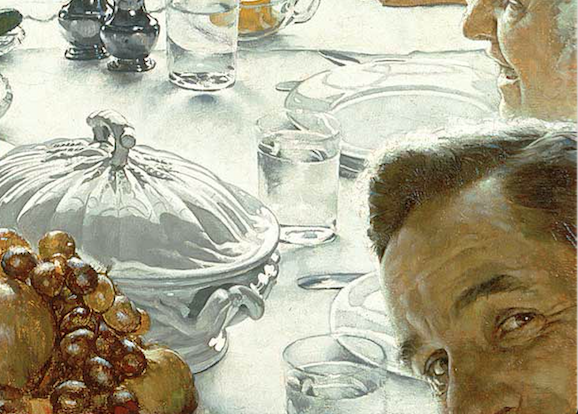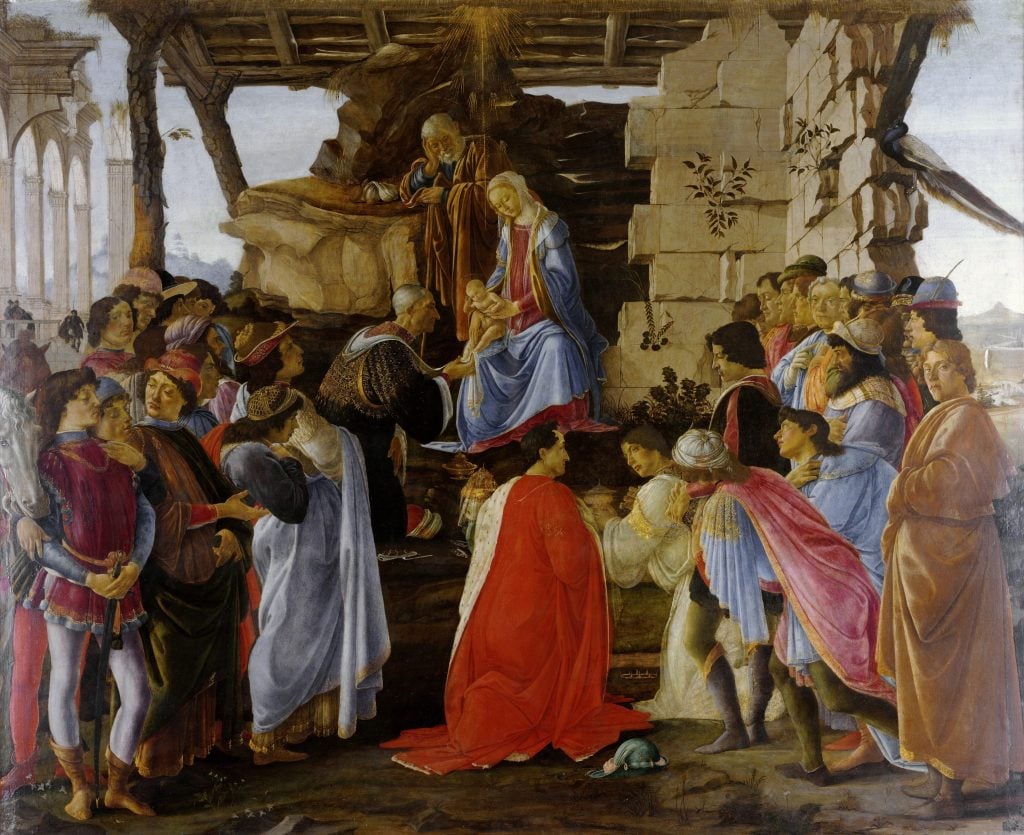Parody Norman Rockwell Four Freedoms Funny
Norman Rockwell's Freedom From Want is one of the most iconic (and parodied) paintings of the 20th century—it's the Thanksgiving painting we know without even necessarily knowing its name.
Appearing in the March 6, 1943 edition of the Saturday Evening Post, it depicts a white, middle-class family seated around a crisply adorned dinner table. As was common for Rockwell, his models for the painting were his friends, family, and neighbors in the town of Arlington, Vermont, whom he photographed in his studio and painted into the complex composition individually (they never sat together).
Rockwell's wife appears on the left side of the table. The family cook, Mrs. Thaddeus Wheaton, was the model for the elderly matriarch serving the turkey. (She did in fact cook the meal used for the painting; Rockwell joked about eating the turkey later.)
Opinions on the famous image are mixed. Many a critic has dismissed it as kitsch, and Rockwell himself thought that it "lacked a wallop."
But many more treasure the image. Deborah Solomon, his biographer, goes so far as to call the light-filled canvas "one of the most ambitious plays of white-against-white since Whistler's Symphony in White, No. 1."
Though seemingly so familiar, there are plenty of details you might have missed aboutFreedom From Want. This Thanksgiving, we've pinpointed three facts that just might change the way you see it.
1) The Military Hated It (Until They Loved It)
The idyllic scene was one in a series of four paintings Rockwell made in response to Franklin Delano Roosevelt's 1941 State of the Union address known as the "Four Freedoms." (The other freedoms were "freedom of speech," "freedom of worship," and "freedom from fear.")
Rockwell had originally wanted to paint the series for the military and, hoping for a commission, sent a charcoal sketch of the "Four Freedoms" paintings to the Office of War Information (OWI). Not only did the brass turn it down, they twisted the knife, writing,"The last war, you illustrators did the posters. This war, we're going to use fine arts men, real artists."

Freedom From Want was reproduced in millions of posters promoting the sale of war bonds. Collection of the Charleston Museum.
Saturday Evening Post editor Ben Hibbs, however, was enthusiastic. And he was right—so popular were the images, in fact, that the magazine decided to offer prints for sale.
The OWI, which had turned down Rockwell just a few months earlier, asked to use prints of the paintings in a war bond campaign that would ultimately garner over $132 million in bonds and stamps.
In the end, millions of posters of Rockwell's paintings were distributed across the country, posted in schools, libraries, and post offices.
2) Some Worried it Was Too Much… Even Rockwell

Norman Rockwell's Freedom From Want in The Saturday Evening Post.
Though Freedom From Want was enthusiastically embraced by the American public, in Europe the happy scene left a bitter taste as the population endured ongoing wartime hardship.
"Freedom From Want' was not very popular overseas," Rockwell later recalled self-critically. "The Europeans sort of resented it because it wasn't freedom from want, it was overabundance, the table was so loaded down with food."
In fact, even before it found success, Rockwell had been worried it would come off wrong. Each image in the Post was accompanied by an essay on the relevant theme. "Freedom From Want" was written by the Filipino immigrant, novelist, and labor organizer Carlos Bulosan, who wrote about the privation and violence endured by Asian immigrants to the West Coast.
"If you want to know what we are, look upon the farms or upon the hard pavements of the city," Bulosan's essay began. "You usually see us working or waiting for work, and you think you know us, but our outward guise is more deceptive than our history."
Once Rockwell had read the essay, he hesitated to complete the painting, aware that the contrast of his happy meal with Bulosan's text could be read as smug ignorance. He contemplated destroying it and starting again, but his editor, Hibbs, begged with Rockwell to finish the painting, saying that illustration and essay need not match, but merely reflect on the same theme.
3) Winking at Art History

Jim Martin, Rockwell's neighbor and a frequent model, peeks out from the canvas.
The military may have dismissed him as not a "real fine art man," but Rockwell (who had never claimed to be anything more than an illustrator) was in fact a wellspring of art-historical knowledge and compositional study.
The Last Supper, arguably art history's most famous meal, was definitely on his mind. Like Leonardo da Vinci's version, the central figures in Freedom From Want are framed by a window, with the perspective lines converging to focus attention on them. The creases in Rockwell's humble table cloth even echo those in the cloth covering Christ's table in the Leonardo.

Leonardo da Vinci, The Last Supper (1490).
Most importantly, theLast Supper also provides a source for the central trope of Rockwell's painting. Famously, in the Last Supper, the Apostles look away from Christ, absorbed in the swirl of their own thoughts and conversations. The same is notably true of the family in Freedom From Want, who are absorbed with everything but the turkey being served. (This art-historical echo also makes the turkey into a sacrament.)
The man on the bottom right of Rockwell's painting, whose partial face glances out cinematically, has garnered a lot of critical speculation.
His features are based on Rockwell's neighbor, Jim Martin, whom the artist included each of his Four Freedoms paintings. But Martin's fourth-wall breaking also riffs on another Renaissance trope, in which one figure stares out from an otherwise self-contained canvas as if to invite the viewer into the composition.
Botticelli, for instance, used a self-portrait in his 1475Adoration of the Magi much the same way, at the bottom right.

Sandro Botticelli, Adoration of the Magi (1475–1476). Collection of the Uffizzi.
Diego Rivera, the Mexican muralist, was inspired to his craft by Renaissance art. In his famous Detroit Industry mural, completed 10 years before Rockwell's Saturday Evening Post portfolio, he similarly inserted the figure of his patron, Edsel Ford, in the lower right corner, looking out.
![Diego Rivera, Detroit Industry south wall [detail] (1932-33), featuring Edsel Ford (in gray suit) and DIA director William Valentiner (in blue suit), depicted holding contract for the murals](https://news.artnet.com/app/news-upload/2020/11/detriot-industry-detail-edsel-ford.jpg)
Diego Rivera, Detroit Industry south wall [detail] (1932-33), featuring Edsel Ford (in gray suit) and DIA director William Valentiner (in blue suit), depicted holding contract for the murals
Thus, the grinning man at the bottom corner of Freedom From Want can be taken as Rockwell winking at art history.
Follow Artnet News on Facebook:
Want to stay ahead of the art world? Subscribe to our newsletter to get the breaking news, eye-opening interviews, and incisive critical takes that drive the conversation forward.
Source: https://news.artnet.com/art-world/norman-rockwell-thanksgiving-freedom-from-want-three-facts-1926485
0 Response to "Parody Norman Rockwell Four Freedoms Funny"
ارسال یک نظر